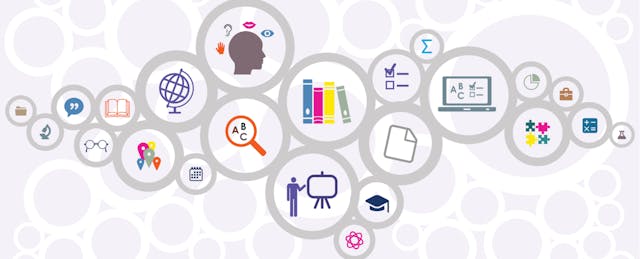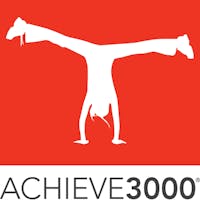Reading was easy for Dr. Doug Fisher when he was growing up in San Diego, but it wasn’t for everybody. “I had friends who were illiterate,” he says. “They just pretended they could read, and the teachers pretended, and they graduated.” As a freshman at San Diego State University, Fisher wrote his first English comp paper on illiteracy in America. “Somehow, that seed was there for a really long time.”
Fast forward: after teaching public health and earning a doctorate in education, Fisher co-founded San Diego’s Health Sciences High and Middle College (HSHMC). The school gives students meaningful vocational experiences—shadowing and working with healthcare professionals or even firefighting professions—while earning a high school degree, community college credentials or vocational certificates. Yet no matter how hands-on the program, literacy remains fundamental. “Literacy can change your life,” Fisher says. “It is one of our best antidotes to poverty.”
Fisher is now a professor of education leadership at San Diego State and a teacher leader at HSHMC. EdSurge talked with him about how he and his colleagues use online differentiated literacy instruction tools from Achieve3000, and how that platform has helped the school’s students—80 percent of whom are eligible for free lunch—achieve a stunning 98.5 percent graduation rate.
Why the focus on health sciences in your school?
Differentiated instruction is the idea that we can meet more students’ needs by changing content, processes and products to keep kids learning at high levels and eventually achieve equitable outcomes.
About 13 years ago, a group of us said we want one demonstration of what’s possible in secondary education. So we looked at what was the number one job need in San Diego, and it was health care, from very entry-level jobs—the person who transports patients in a hospital—up to specialist physicians. And even if you don’t want to be a healthcare worker, you would do well to understand your own health and what puts you at risk. About 55 percent of our students end up working in health care.
When did you realize how fundamental literacy would be to the program you were creating?
From the beginning. In the founding documents of the school we talked about literacy being a gateway to all of learning. If you don’t have high levels of literacy, you are at risk for so many adverse life events, like poverty. You won’t be successful in your science and history classes, and the job range is very limited.
What does ‘differentiated literacy instruction’ mean, and what does it look like in the classroom?
In the world of literacy, I think we differentiate in a couple of ways. We engage in teacher modeling, where we share our own thinking as an example using grade-level text or higher; we do small-group instruction where we look at text that will stretch students; we have students work with their peers in some sort of collaborative conversation; and lastly, we have kids work independently. When there’s no peer or teacher support, they have to be able to read and learn from the text.
That’s a big part of what Achieve3000 has done. They have created independent readings that are just above students’ current reading levels. As students make progress from all the other forms of instruction, the text becomes increasingly complex.
To learn more about differentiated literacy instruction, download this infographic → How to Navigate the Needs of (M)any Student(s) So All Paths Lead to Learning or this eBook → Differentiated Instruction for Acceleration and Equity.
How would that work in a class of ninth graders, if one student reads at a sixth grade level and another reads at an eleventh grade level? Are they both reading about the same topic in text tailored to their levels?
The topics are the same. The Achieve3000 system redoes the text: It changes vocabulary. It changes sentence structures and approximates the current reading level—plus a little bit—for that student. Sometimes you do lose some of the details in a less complex text, but the topic can still be discussed as a whole class or in a group because they’ve all read the same kinds of things.
How does that bring equity and energy into the classroom?
At our school we focus on Lexile growth. If I want to be a YouTuber, or I want to be a nurse, or I want to go in the Army, there is all this evidence about how well you have to read to be successful in that job. So students set goals that say: I’m going to graduate in three years and I want to be in the Army, so I have to read at a least at an 1100 if not 1200 Lexile level. Being very goal-driven and seeing the relationship between how well you read and the kind of job you’re looking for helps students develop the motivation and energy to actually give it a try.
Can you give me an example of a topic you’ve discussed with students of different reading levels using Achieve3000?
A class of ninth graders recently had a discussion on gender equity pay in sports, based on a set of articles from Achieve3000. One article argued that the spectators for most female sports are not willing to pay very much for admission, and that there aren’t a lot of spectators. But in male sports, there’s a lot more money coming in, so of course the players make more. Others argued that that gap happens because of the lack of promotion, and a lack of marketing.
So we deployed these articles through Achieve3000 and kids read them at their levels—plus some. They went through the thought questions and activities. Then we had a class discussion about it. Kids were bringing ideas from the text, and they were talking about their own experiences because who do they see on TV? Then they started talking about their school and asking questions: Do we have gender equity in how many girls’ sports vs. boys’ sports we have? Can boys play on girls’ teams? Can girls play on boys’ teams? It turned into this really interesting conversation.
When and why did you decide to try Achieve3000?
This is our seventh year of using Achieve3000 Empower, which is the high school level system. Before, we were doing mostly small-group teacher-led interventions with kids. That can meet a lot of needs, but there are so many needs, you end up running out of time because class is over. Then one of the teachers heard about Achieve3000 at a conference and wanted to try it. She implemented it in her English class, and the students had this kind of love-hate relationship with it. They loved seeing their Lexiles grow, but they did not like doing all the work. There are a lot of parts to it, including reading and answering comprehension and vocabulary questions. Now, Achieve3000 is used by our science and social studies classes.
Has Achieve3000 made it possible to support a larger and more diverse collection of students?
Yes, in part because it provides a lot of practice that teachers just can’t. Kids are practicing their reading, but they are also practicing their writing and thinking by responding to questions. Achieve3000 also provides a dashboard that helps teachers track student progress.
Can you think of an individual who has been profoundly impacted by Achieve3000?
There was a young man who really did not read well, who really struggled and as a result his behavior was not great. He was a very difficult young man. But he grew his Lexile in a very impressive way. He had great teachers, and he did the practice because we made him. He went to the military for four years, and he came back to San Diego. And he now is in a degree program to become a counselor for high school students.
Aside from Lexile growth, how do you measure success?
Our high school graduation rate is 98.5 percent, and 80 percent of our students are eligible for free lunch. We have a lot of success with kids getting into the military who probably wouldn’t have because their reading scores weren’t high enough; we have a lot of college success. Over 70 percent of our students complete two semesters of college classes before they graduate high school. Before we started using Achieve3000, we had just a small, select group of kids taking college classes.
Where do you see literacy education moving?
I think the future of literacy is about providing the inspiration to take action, to build public spirit. I think that’s in part why digital literacy is very popular and very important in our work. Digital literacy allows the student to respond to the reading: they blog or they post or they respond or they like.
As for the benefits of differentiated learning, evidence shows that white kids get more choice, quality and range in what they read than kids of color do. With Achieve3000, all our kids are getting rich, high-quality informational text. No one is told, ‘Because you read poorly, you have to read this over there.’ That brings equity to the classroom.



